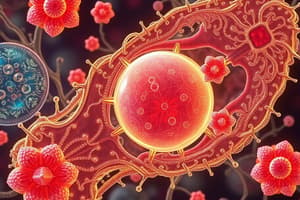Podcast
Questions and Answers
What is the primary function of the nucleus in a eukaryotic cell?
What is the primary function of the nucleus in a eukaryotic cell?
- Facilitates cellular respiration
- Site of protein synthesis
- Regulates cell motility
- Contains the cell genome (correct)
What feature of the nuclear membrane allows it to control the movement of substances?
What feature of the nuclear membrane allows it to control the movement of substances?
- Double lipid bilayer
- Rigid structure
- Selectively permeable pores (correct)
- High protein concentration
Which organelle is responsible for ribosomal RNA synthesis?
Which organelle is responsible for ribosomal RNA synthesis?
- Golgi complex
- Nucleolus (correct)
- Mitochondria
- Endoplasmic reticulum
Which of the following cytoplasmic structures is responsible for digesting macromolecules?
Which of the following cytoplasmic structures is responsible for digesting macromolecules?
What is the primary role of the Golgi complex in a eukaryotic cell?
What is the primary role of the Golgi complex in a eukaryotic cell?
What is the function of a peroxisome in a eukaryotic cell?
What is the function of a peroxisome in a eukaryotic cell?
Which component is NOT part of the cytoskeleton?
Which component is NOT part of the cytoskeleton?
What is the primary composition of the cell wall in plant cells?
What is the primary composition of the cell wall in plant cells?
What is the primary function of the cell envelope in prokaryotic cells?
What is the primary function of the cell envelope in prokaryotic cells?
Which process is NOT a function of the cytoplasmic membrane?
Which process is NOT a function of the cytoplasmic membrane?
Which type of transport involves movement against a concentration gradient and requires energy?
Which type of transport involves movement against a concentration gradient and requires energy?
What characterizes group translocation in bacterial cells?
What characterizes group translocation in bacterial cells?
What is the composition of the peptidoglycan layer in the bacterial cell wall?
What is the composition of the peptidoglycan layer in the bacterial cell wall?
Which mechanism directly uses ATP to transport solutes into the cell?
Which mechanism directly uses ATP to transport solutes into the cell?
Which of the following statements about the plasma membrane is true?
Which of the following statements about the plasma membrane is true?
Under anaerobic conditions, iron is generally in what state?
Under anaerobic conditions, iron is generally in what state?
Flashcards are hidden until you start studying
Study Notes
Eukaryotic Cell Structure
- Nucleus contains the cell's genome, bound by a double lipid bilayer membrane.
- Nuclear Membrane exhibits selective permeability due to pores.
- Nucleolus is rich in RNA, responsible for ribosomal RNA synthesis.
Cytoplasmic Structures
- Endoplasmic Reticulum (ER) is a network of membrane-bound channels continuous with the nuclear membrane.
- Rough ER is studded with ribosomes, involved in protein synthesis and modification.
- Smooth ER lacks ribosomes, involved in lipid synthesis, detoxification, and calcium storage.
- Golgi Complex is a stack of membranes that work in concert with the ER, involved in protein sorting, packaging, and secretion.
- Plastids are organelles with their own DNA.
- Mitochondria are involved in cellular respiration.
- Chloroplasts are responsible for photosynthesis in plants.
- Lysosomes are membrane-bound vesicles containing digestive enzymes for breaking down macromolecules.
- Peroxisomes are membrane-bound structures that produce hydrogen peroxide (H2O2) from the reduction of oxygen by various hydrogen donors.
- Cytoskeleton is a three-dimensional structure that fills the cytoplasm and provides support and movement.
- Microfilaments are composed of actin, involved in cell shape, muscle contraction, and cell movement.
- Intermediate Filaments provide structural support and anchor organelles.
- Microtubules are composed of tubulin, involved in cell division, organelle movement, and cilia/flagella formation.
Cell Wall
- Surface layer can be composed of polysaccharides (cellulose or chitin) or inorganic materials (e.g., silica in diatoms).
Motility Organelles
- Flagella are long, whip-like structures used for locomotion.
- Cilia are short, hair-like structures involved in movement of fluids or particles.
Prokaryotic Cell Structure
- Nucleoid is the region where DNA is packaged in prokaryotic cells.
- Cell Envelope protects the prokaryotic cell from hostile environments, including osmolarity, chemicals, and antibiotics.
- Plasma Membrane also known as the bacterial cytoplasmic membrane, is responsible for:
- Selective permeability and transport of solutes
- Electron transport and oxidative phosphorylation in aerobic species
- Excretion of hydrolytic exoenzymes
- Biosynthesis of DNA, cell wall polymers, and membrane lipids
- Chemotactic and other sensory transduction systems.
Permeability and Transport Mechanisms
- Passive Transport relies on diffusion, doesn't require energy, and operates when the solute concentration is higher outside the cell.
- Simple diffusion movement across a membrane from high to low concentration.
- Facilitated diffusion movement across a membrane with the aid of transport proteins.
- Channel proteins form pores in the membrane.
- Active Transport requires energy to move solutes against their concentration gradient.
- Ion coupled transport uses pre-established ion gradients (proton or sodium motive force) for transport.
- ABC Transport directly uses ATP to transport solutes into the cell.
- Group Translocation a type of vectorial metabolism where a molecule is modified as it is transported, not considered active transport as no concentration gradient is involved.
- Special Transport Processes specific mechanisms for transporting certain molecules, such as iron uptake systems.
The Cell Wall
- Peptidoglycan Layer is a complex structure found in bacterial cell walls, composed of:
- Backbone of alternating N-acetylglucosamine and N-acetylmuramic acid, linked by β1→4 linkages.
- Tetrapeptide side chains attached to N-acetylmuramic acid.
- Peptide crossbridges that link the tetrapeptide side chains.
Bacterial Plasma Membrane
- Functions include:
- Permeability barrier
- Protein and lipid synthesis
- Energy generation (electron transport and oxidative phosphorylation)
- Signal transduction
- Contains transport proteins for various molecules across the membrane.
Studying That Suits You
Use AI to generate personalized quizzes and flashcards to suit your learning preferences.




